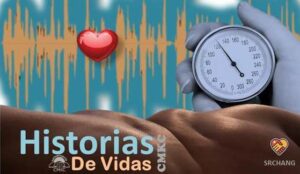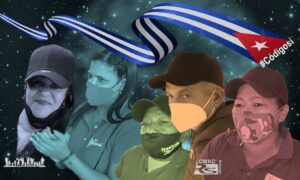

Imagen web: Santiago Romero Chang.
COVID-19- Voices around the world are reviewing the first year of this lethal pandemic, which has disrupted agendas of all types on the planet.
COVID-19- Between March 11, 2020 and the same day in 2021, so many events have transpired – so many unprecedented – that what we have experienced is beyond the capacity of these newspaper pages.
But we are alive, and confident that the day will come when there will be no deaths, no one in serious condition, no one infected. Hope lies in massive immunization of the population and in the power of solidarity, thus we propose a summary of what has happened in Cuba as this period draws to a close.

1. National prevention and control plan for the new coronavirus
Before the appearance of the first cases here, Cuba had designed and begun implementation of a series of measures to combat the disease.
Army General Raúl Castro Ruz, Party first secretary, insisted on the need for a national strategy that could be refined as more became known about the SARS-COV-2 virus.
Based on that directive, on January 29, 2020, the Council of Ministers approved a COVID-19 Prevention and Control Plan. On February 12, the COVID-19 Science Group was created. While on February 17 and 26, respectively, the COVID-19 Health Observatory and the Innovation Committee were established.
On February 28, the first five research projects focused on COVID-19 were approved. By June 1, 460 research projects were underway, of which 85 were led by the National Technical Group’s Science Group.
Nurse Yaquelín Collado Rodríguez was discharged from the hospital, after 59 days, including 37 in intensive care. Photo: Freddy Pérez Cabrera
On March 3, 2020, the Party Political Bureau approved an update of the Plan, with 497 measures; and on June 9, taking into account the experience gained, a strategy for the post-COVID-19 recovery stage was adopted, including 220 measures to be implemented over three phases. This plan was approved by the Executive Committee and the Council of Ministers on June 10.
2. First cases of COVID-19 reported in Cuba
On March 10, 2020, four Italian tourists with respiratory symptoms were identified while staying at a hostel in the city of Trinidad, in the province of Sancti Spíritus. They were immediately admitted to the Pedro Kourí Tropical Medicine Institute (IPK) in Havana.
On March 11, 2020, the IPK’s national reference laboratory reported that three of the four tourists isolated since March 10 had tested positive for the new SARS-COV-2 coronavirus. On the same day, the disease was declared a pandemic at the international level by the World Health Organization (WHO).
Army General Raúl Castro and President Díaz-Canel activated provincial defense councils, with a reduced number of members, to support the response. The activation of municipal defense councils, as needed, was also projected.
3. Regular press conferences keep the population informed
One of the most important communicational efforts of 2020 were the daily transmissions on national television of press conferences offered by the Ministry of Public Health (Minsap), conducted by its national director of Epidemiology, Dr. Francisco Durán García, who has responded to the people’s many concerns related to the evolution of the pandemic in our country, contributing to increasing risk perception and awareness of the need to reinforce hygienic-sanitary precautionary measures.
4. The first death in Cuba
In the early morning of March 18, a 61-year-old Italian patient, who had been admitted to the IPK’s intensive care unit in critical condition, died – a sad moment for the nation.
5. First Cuban infected with SARS-COV2, also the first to be discharged from the hospital
The first Cuban infected with the new coronavirus, young Jesús Álvarez, resident of Santa Clara, was also the first to be discharged from the hospital.
6. The longest hospital stay, due to COVID-19
On May 22, 2020, in Villa Clara, nurse Yaquelín Collado Rodríguez was discharged from Comandante Manuel Fajardo Military Hospital, after spending 59 days there, including 37 in ICU, in critical or serious condition.
She fell ill while serving on a mission in Venezuela, and hers was to be one of the most difficult COVID cases faced by Cuban medical science.
7. No deaths among pregnant women or children
On March 22, 2020, Santiago de Cuba reported the first pediatric COVID-19 patient in the country. Almost a year later, on March 2, 2021, assisted in Villa Clara was the first birth by a mother with COVID-19 and in critical condition. Cuba has recorded the cases of only one child with Multisystemic Inflammatory Syndrome, who recovered successfully; two cases of Kawasaki Disease, associated with COVID-19, also recovered, and an adolescent with Hemophagocytic Syndrome, also linked to the new coronavirus, who developed organ failure, and is now recuperating. No child or adolescent has died as a result of the epidemic, but more than 6,300 have been infected.
Thirty-five COVID-19 landmarks in Cuba https://t.co/3eEBK2Jvur @LaCmkc #ConquistandoUnSueno @IndioMayari @Santiag03419459 @oshun1958 @Toar21640791 @Pasarn3 @aguilarpaloma1 @CmkcConcierto @arevalo_eglis @YeroChao @CamiloteGG @PieriXioma
— Compay Naguito (@CompayNague) April 12, 2021
8. Cuba receives the British cruise ship MS Braemar, when no one else dared to do so
In a commendable humanitarian gesture, on March 18, 2020, Havana received the British Fred Olsen cruise line’s MS Braemar, with 682 passengers and 381 crew members on board, including five diagnosed with COVID-19, and another 40 suspected cases of the new coronavirus. The ship had been seeking safe harbor in several Caribbean ports since the end of February, but all of its requests had been denied. The Cuban government was the only one in the region willing to respond positively.
9. Thousands of citizens stranded abroad guaranteed return to Cuba
According to data from the Cuban Ministry of Foreign Affairs, between March 21 and October of 2020, 94 charter flights were organized to return home more than 5,700 Cubans stranded in 56 countries. Consular assistance was provided to Cuban crew members working on more than 12 cruise ships and more than 20 merchant vessels, which had ceased operations and were docked in different countries.
Likewise, the Cuban government, among other measures, implemented automatic, cost-free extension of continuous stays abroad for Cuban citizens resident in the country, beyond the established 24 months, as of March 19, 2020.
10. Brigades from the Henry Reeve International Contingent of Doctors Specialized in Disaster Situations and Serious Epidemics battle COVID-19 around the world
On March 15, the first brigade of advisors departed from Havana to Venezuela. Since then, Cuba has sent 56 Henry Reeve brigades to 40 countries. These medical professionals have assisted 1,090,799 persons in Latin America and the Caribbean, Europe, Africa and Asia; thus extending Cuba’s treatment protocol to other countries, according to the Minsap website.
In recognition of this work, a passionate international movement is proposing the 2021 Nobel Peace Prize for our doctors.
Photo: Ricardo López Hevia
11. Donations and solidarity with Cuba
In 2020, donations were received mainly from organizations of the United Nations system and countries in solidarity with Cuba. The Ministry of Foreign Trade and Investment has reported more than 400 donations from 27 nations and eight international cooperation agencies, in addition to aid to individuals. A bank account was also opened for generous individuals who wish to make a financial donation.
12. National network of COVID-19 diagnostic laboratories expanding
When the epidemic began, the country had four such institutions, with a capacity of 100 tests per day. At this time, 22 molecular biology laboratories are in operation, processing some 20,000 tests a day. A lab in the province of Mayabeque, now in the start-up phase, is in the latest to be opened.
13. Cuba has developed five candidate vaccines and could become the first Latin American and Caribbean country to produce its own COVID-19 vaccine
Cuba has five candidate vaccines in different phases of clinical trials: Soberana 01 and Soberana 02, from the Finlay Vaccine Institute; Abdala (CIGB-66) and Mambisa (CIGB-669), from the Center for Genetic Engineering and Biotechnology, and Soberana Plus, recently added. The latter is a formulation being evaluated as part of the Soberana 01 project, which will be developed as a booster vaccine and administered to convalescent patients or in combination with other vaccines.
The island’s COVID-19 vaccine program began in May of 2020, and clinical studies began in August, with two formulations of Soberana 01. These candidate vaccines were approved after rigorous testing and review by the Center for State Control of Drugs, Equipment and Medical Devices (Cecmed).
14. Hyperimmune plasma from recovered patients key to saving those in serious and critical condition
The use of hyperimmune plasma from patients convalescing from COVID-19 began in Cuba in April of 2020 as one of the treatment alternatives to confront the pandemic.
15. The Ministry of Public Health’s action protocol
In May of 2020, Minsap published the National Action Protocol for COVID-19. In August, an updated version was issued to optimize patient care and reinforce the protection of health workers and the population. The latest version dates from January 2021 and includes newly developed protocols for high-risk and asymptomatic patients.
16. Recombinant Human Interferon Alpha 2B, PrevengHo-vir, Biomodulin-t and Itolizumab
Early on in the COVID battle, in February of 2020, recombinant human Cuba’s Interferon Alpha 2B, became known as one of the drugs used effectively in China against the coronavirus.
PrevengHo-vir, used as a preventive since April 2020; Jusvinza, authorized for emergency use; Biomodulin t, administered to older adults aged 60 and over, and Itolizumab, an anti-inflammatory treatment for COVID patients, have been key medications, developed and manufactured in Cuba.
17. Cuba achieves its first nanotechnology-based innovation, a PCR diagnostic kit
In February of 2021, the design and production of a PCR diagnostic kit, the first nanotechnology-based innovation developed by researchers at the Center for Advanced Studies, was introduced.
18. BioCen succeeds in developing the first transport medium for viruses manufactured in Cuba
In October of 2020, researchers at the National Center for Biopreparations (BioCen) developed the first virus transport medium manufactured in Cuba, intended for use in the collection and transportation of nasopharyngeal and oropharyngeal samples from patients to be tested for the presence of SARS-COV-2.
19. Administration of Nasalferon to travelers and their families
Since January 7, 2021, the drug Nasalferon has been administered to travelers and their families arriving in Cuba, to strengthen their immune systems and prevent replication of the SARS-COV-2 virus. Today, its application is being extended to other vulnerable groups.
20. Volunteers provide crucial support at isolation and screening centers
Hundreds of thousands of young people have shown their solidarity by collaborating in isolation centers; in active epidemiological investigations in communities; in hospital red zones, and many other arenas of critical importance, including the Family Care System and food production.
21. Social security and unemployment protection
Under the humanist principle which distinguishes the Revolution, and in spite of the tightening of the U.S. economic blockade of our country and the negative impact of COVID-19 on the national economy, the Ministry of Labor and Social Security has implemented job and wage protection, social security and assistance measures to ensure that no Cuban is left unprotected from the epidemic’s impact on the economy.
Telecommuting and distance work were encouraged at full salary; while benefits were provided to workers 60 years of age and older; mothers, fathers and guardians with young children in early childhood, primary and special education, and other vulnerable persons.
More than 247,300 self-employed workers, whose activities were suspended, were exempted from paying taxes and fees, and benefits such as the extension of taxpayer registration, deferrals and suspension of taxes due for hired workers were adopted.
22. Implementation of national economic and social development strategy
A strategy to boost the economy and confront the crisis was approved by the Council of Ministers on July 16, 2020, under the principles of defending national production, encouraging exports and providing the enterprise sector with greater autonomy, among other elements.
As part of the strategy, President of the Republic Miguel Díaz-Canel Bermúdez and his work team resumed government visits to the provinces.
23. Guarantees for safe tourism
In strict compliance with measures established for certification as safer and more hygienic tourist facilities, November 15, 2020, Cuba began the reopening of airports and the tourism sector, as the battle against the pandemic continued.
24. Food production promoted
Given the complex situation caused by COVID-19 and the Trump administration’s obsessive escalation of the economic blockade, food production has been a priority issue for the country’s leadership.
25. The challenge of commerce and services
Under the premise that no Cuban would be left without support, courier services, preparation of take-out meals and the delivery of essential products to quarantined communities were organized.
26. Computer applications to facilitate services
Several payment services were created in 2020 through e-commerce and point-of-sale (POS) terminals. In addition to mobile banking, Telebanca, ATMs and Transfermóvil, applications such as the Viajando and TuEnvío apk were introduced. For monitoring, control and information on the pandemic, applications such as COVID-19-Infocu and the virtual researcher were designed.
27. Cities on pause, but with uninterrupted transportation
Transport workers have been unconditional participants in the COVID battle, transporting patients and those suspected of infection to hospitals and isolation centers. They also guaranteed transportation for health personnel in areas where the epidemiological situation required the suspension of customary bus and cab routes.
They were responsible for the daily transfer of thousands of PCR test samples and persons who were stranded away from home by a worsening epidemiological situation.
28. Strategies to address the impact of isolation
From the field of social sciences, action was taken to provide support during isolation, including telephone advise via the Confidential Line for Life, and the 103 Help Line; the publication of self-help texts; and the active role on WhatsApp of therapy groups organized by the Cuban Psychology Society’s guidance section.
It was possible to maintain the vitality of the teaching-learning process at home, through the broadcasting of television classes.
29. Culture consolidated as the soul of the nation
Within the context marked by COVID-19, the tightening of the U.S. blockade and escalating subversive campaigns against our country, the Ministry of Culture and its institutions, far from being discouraged, expanded their work.
Given the postponement of large artistic events, nearly 200 concerts were broadcast online, while the Havana International Festival of New Latin American Cinema presented a selection of works on Cuban television, which has also added new family-oriented programs.
30. Athletes continue training for international competitions
With the risk of COVID-19 as a constant threat, and the decision to conduct the National Baseball Series without fans in the bleachers, and the play-offs in bubble mode, the season has been a great victory for Cuba’s sports movement during the pandemic.
With their sights set on the Tokyo Olympics, athletes and coaches have been obliged to resort to a variety of initiatives over the past year to get in shape for the 2021 Games.
31. Historic dates have not been overlooked
From doorways and balconies, online, in open spaces, or symbolically, the Cuban people have celebrated May Day, July 26th and the anniversary of the triumph of the Revolution, January 1st.
32. National Assembly legislative work advances despite the pandemic
The legislative schedule was affected in 2020, but standing committees continued their work. As a result, approved were laws governing the Foreign Service; recall of elected officials; the Organization and Functioning of the Council of Ministers, the President and Vice President of the Republic, Provincial People’s Power bodies, and that of Municipal Administration Councils.
33. Provocations and subversion financed by the U.S.
Over the last two decades, through several administrations, close to 250 million dollars have been allocated to a series of programs intended to destroy the Revolution. During the Trump administration, more than 240 hostile measures against the island were adopted, and those of 2020 were particularly aggressive, including the elimination of remittances sent from that country via Western Union, further restrictions of flights and the denial of access to medical supplies and donations.

34. Recognition from ALBA and Caricom for Cuba’s COVID strategy
Cuba’s regional response to the pandemic was recognized by foreign ministers participating in the xxi Political Council of the Bolivarian Alliance for the Peoples of Our America-People’s Trade Treaty, and later, by heads of state and government of the Caribbean Community (Caricom).

35. Preparations for the Party Congress advance
As announced, the 8th Congress of the Communist Party of Cuba will take place April 16-19. The historic event will focus its attention on evaluation of core issues and key projections for the present and future of the nation.
(Taken from Granma)























